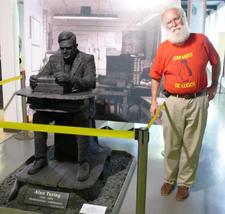Stiff Upper Lip

Paw Prints: Writings of the maddog
You have to admit that the British have a unique way of doing things from time to time. This is why I enjoy going to London, even when I have to suffer a two-day subway strike just at the time my conference is being held.
The conference was the Open Mobile Summit, being held June 10th and 11th. This conference is normally aimed at management of telephony companies, either carriers, handset manufacturers or software designers. Due to the name, you might imagine that these people would talk about being "Open". Some of them did, but most were still suffering the same old paths of trying to tie the phone to a carrier, and the carrier to a set of services that no one really wanted.
The conference did allow us to talk over our differences, and each time I go to one of these events (the next one is in San Francisco) I keep hoping that one or more large carriers will see the light, or that one of the handset manufacturers will honestly learn what "open" means and apply it to their products.
However, this blog entry is really about two sights in London, the Royal Observatory and Bletchley Park.
I went to London this time with two major missions.
I wanted a video, or at least a picture, of John Harrison's marine chronometers, on display at the Royal Observatory. Much has been written about the struggle of John Harrison, a carpenter and self-taught clock maker who tackled one of the world's big problems, the solving of longitudinal navigation, so I will not go into that here. What I wanted to discuss, aided by photos of his clocks, was the fact that Harrison, having been awarded the prize money for creating the solution to calculating longitude was not allowed to patent his designs for the clocks. Not patenting the design allowed other clock makers to duplicate his work, but to also compete on cost reducing the final designs so that the marine chronometers would become so inexpensive that even the meanest and smallest of ocean going boats could afford one. If Harrison had been allowed to patent his design, the same competition might not have unfolded, and only the very rich captains could have afforded the clock for a certain period.
Unfortunately after traveling an hour by underground (the strike was over by then), I managed to reach the Royal Observatory (where the clocks are kept), only to be told that no one was allowed to photograph them. If I wanted to do that, I would have had to submit a written request months before......
So I had to be content with buying a couple of picture postcards of the clocks. The problem is that those postcards are copyrighted, and I can not just scan them in and post them on the Internet.
The next day's trip was more successful. I was going to Bletchley Park, home of the World War II effort to break the German's secret codes. I went with a young friend of mine that I had met in London. He was from Brazil, and his father had been working in London for about eleven months. My friend was into computers, electronics and portable telephones, so I thought he might like seeing where a good portion of computing history started.
Four main centers of interest were Bletchley Park itself, the Bombe machines (simple mechanical devices used to help break simple codes), the Colossus (the first partially programmable, digital electronic computer), and the statue of Alan Turing (a personal hero of mine).
For those of you who are unfamiliar with Bletchley Park, suffice it to say that it was where thousands of people worked feverishly (based on work done by Polish code breakers before Poland was occupied by the Germans) to break secret messages and use the intelligence to thwart plans of the German war machine. By the standards of today these machines may seem crude, but they sprung from the minds of people like Tommy Flowers (the engineer who built the Colossus) and Alan Turing.
The machines at Bletchley Park were destroyed after the War and the people working at Bletchely Park were sworn to secrecy, in case the war started again the Germans would not know that the Allies had broken their codes. No one knew until the 1970s that the German codes had been broken, and that the Colossus even existed at all.
Thousands of people walked through the gates of Bletchley Park, commuting every day to their work from the homes and apartments where they lived. No one spoke of what they did, even over thirty years later.
Years later, when the project was declassified, members of the project working with parts scavenged from retired telephone equipment have produced a working model of the Colossus.
When you are in London, take a short train ride to Bletchley Park. Watch the Colossus "solve" encrypted messages as the originals did sixty years before. Remember to thank the people whose innovations were fueled by civic pride and duty to humanity.
comments powered by DisqusSubscribe to our Linux Newsletters
Find Linux and Open Source Jobs
Subscribe to our ADMIN Newsletters
Support Our Work
Linux Magazine content is made possible with support from readers like you. Please consider contributing when you’ve found an article to be beneficial.

News
-
Zorin OS 18 Hits over a Million Downloads
If you doubt Linux isn't gaining popularity, you only have to look at Zorin OS's download numbers.
-
TUXEDO Computers Scraps Snapdragon X1E-Based Laptop
Due to issues with a Snapdragon CPU, TUXEDO Computers has cancelled its plans to release a laptop based on this elite hardware.
-
Debian Unleashes Debian Libre Live
Debian Libre Live keeps your machine free of proprietary software.
-
Valve Announces Pending Release of Steam Machine
Shout it to the heavens: Steam Machine, powered by Linux, is set to arrive in 2026.
-
Happy Birthday, ADMIN Magazine!
ADMIN is celebrating its 15th anniversary with issue #90.
-
Another Linux Malware Discovered
Russian hackers use Hyper-V to hide malware within Linux virtual machines.
-
TUXEDO Computers Announces a New InfinityBook
TUXEDO Computers is at it again with a new InfinityBook that will meet your professional and gaming needs.
-
SUSE Dives into the Agentic AI Pool
SUSE becomes the first open source company to adopt agentic AI with SUSE Enterprise Linux 16.
-
Linux Now Runs Most Windows Games
The latest data shows that nearly 90 percent of Windows games can be played on Linux.
-
Fedora 43 Has Finally Landed
The Fedora Linux developers have announced their latest release, Fedora 43.

